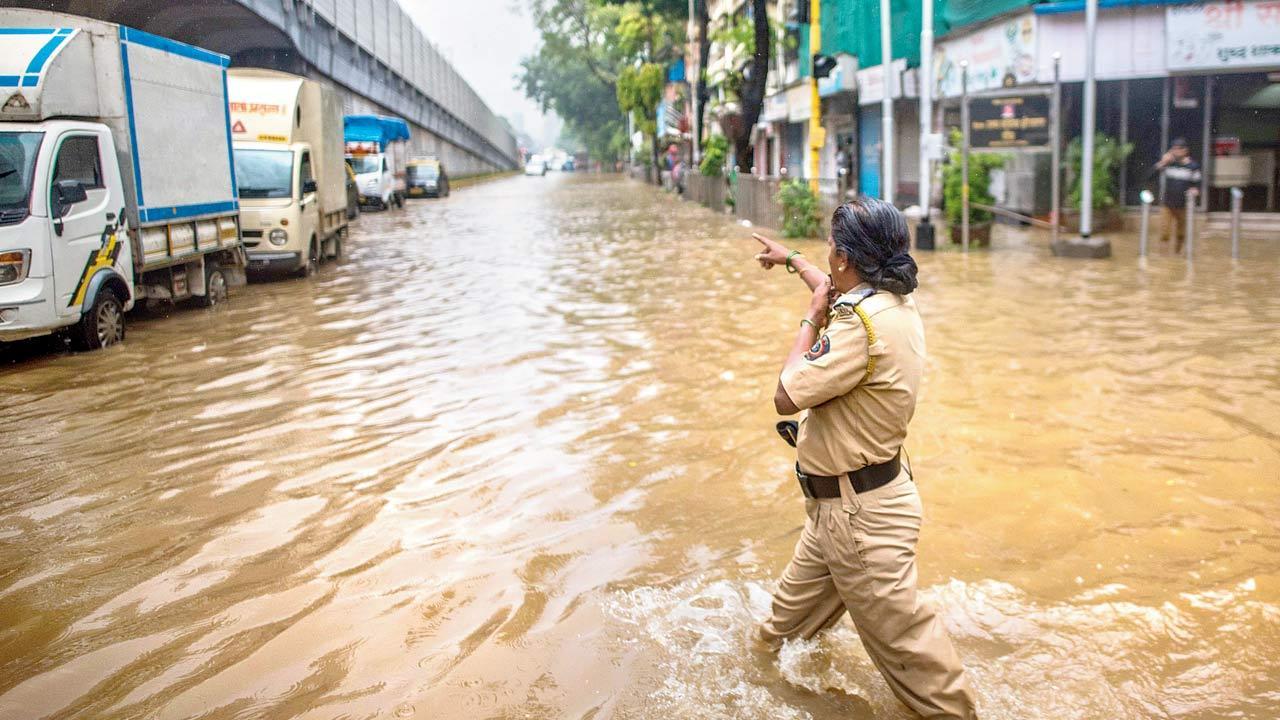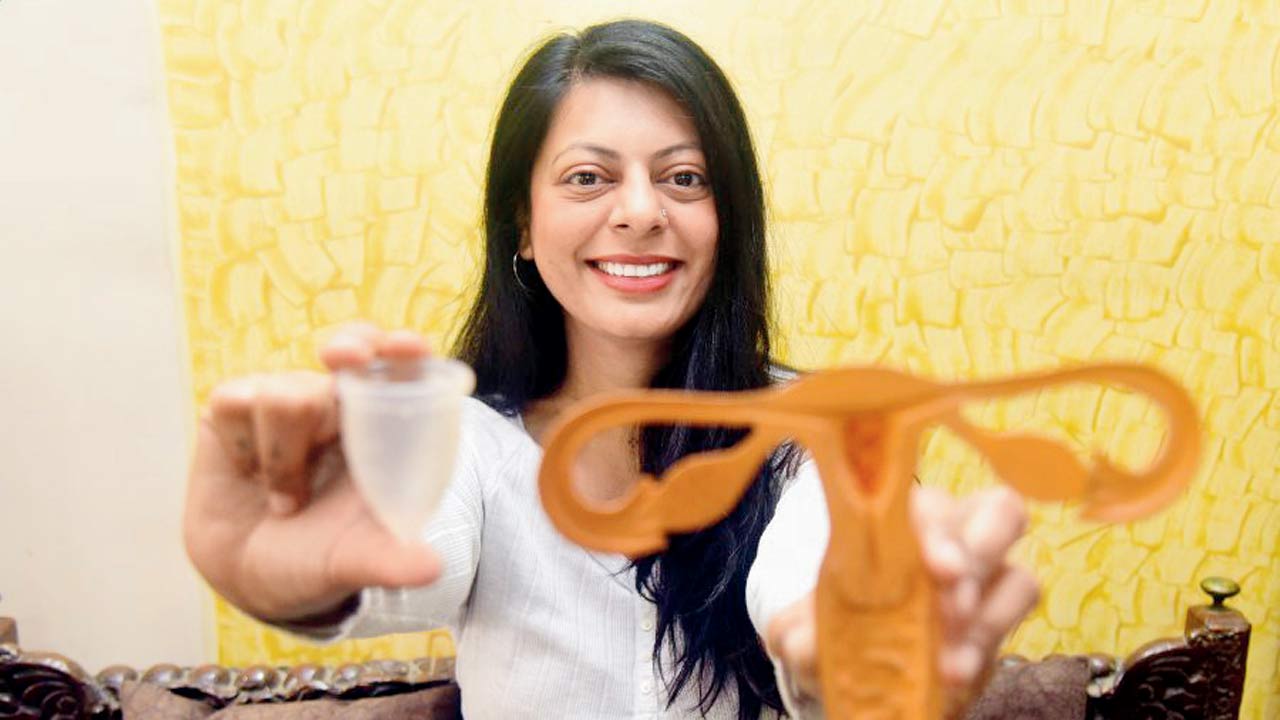A Borivali website designer and female health advocate is out to convert women in uniform into menstrual cup champions. This, at a time when just over 50 per cent of urban Indian women use hygienic period protection

Police women, like this one manning the situation at waterlogged Hindmata Junction during the Mumbai monsoon, are on their feet and out most of the day, rarely having easy access to clean toilets. Pic/Getty Images
When this writer expressed the desire to discuss menstrual health with a female police official for this article, she instantly agreed. But, had a counter request: May I speak with a woman in your team?
ADVERTISEMENT
Chatter around periods and tools of menstrual hygiene in much of India continue to be an absolute taboo or difficult and uncomfortable. What is not brought to the table for discussion cannot easily become priority. It’s the toughest challenge that Dipti Kashalkar, 34, faces as she ploughs through hesitation, meeting women and encouraging them to ask questions about menstruation. Her core interest group is female police officers. In the two years that the Borivali-based independent website designer has spent raising awareness, the one common emotion she has encountered is doubt. And that has much to do with what she is championing--the menstrual cup. The reusable, small, flexible hygiene device that women insert in the vagina to collect menstrual fluid is usually made of medical-grade silicone or thermoplastic isomer.
 Dipti Kashalkar has been holding awareness camps and using free sampling to promote the use of the menstrual cup among female police officials in Maharashtra since 2021. Pic/Shadab Khan
Dipti Kashalkar has been holding awareness camps and using free sampling to promote the use of the menstrual cup among female police officials in Maharashtra since 2021. Pic/Shadab Khan
Shaped like a bell, it has a stem or ring to handle it. Instead of absorbing the flow like a sanitary pad or tampon does, the cup catches and collects it. The user can wear it for upto 12 hours depending on flow, empty it, wash and reuse at will. Financial savings (The Indian woman spends roughly R300 a month on pads) and reduced environmental impact (single use pads end up in landfills, takes up to 800 years to decompose if at all) top the menstrual cup’s sales pitch. “It’s all very well to say we are in the 21st century, but most Indian women continue to know very little about menstrual health. Back when I was in school, the female reproductive system chapter was skipped altogether [in biology class]. Today, with better access to smart phones and the Internet, awareness has improved slightly but we are still a long way off,” says Kashalkar, who is the founder of non-profit Upasana Society, which she set up in 2016.
The menstrual cup campaign has its genesis in a January night of 2020 when she was at Marine Drive, strolling down the promenade after a work call when she saw a group of policewomen patrol the stretch at the late hour. Having worked in menstrual health for five years, a curious Kashalkar walked up to one of them and chatted about how she managed duty hours when menstruating. To her utter but pleasant surprise, she learnt that the officer was a menstrual cup user. “She was of course, part of a minuscule minority. She said she had taken to it after her best friend recommended it but her colleagues had been uncomfortable to even discuss the topic. She spoke of the double shift [16 hours] and their scant access to toilets, let alone clean ones,” Kashalkar remembers. During the unforgiving Mumbai monsoon or if the women are assigned bandobast duty, like during Ganeshotsav or Navratri, a single shift could stretch up to 12 hours.
This chat inspired Kashalkar to approach the Mumbai Police Headquarters in Crawford Market for a discussion for holding awareness camps, but the COVID-19 pandemic hit the brakes on her plans. The lockdown made it only more compelling for her to reach out to marginalised women, including adivasis in the Dahanu-Palghar belt. “I had only recently shifted my focus to menstrual cup use,” she says, “It costs R500, but can be used for up to eight years. Our landfills are choking with pads and tampons. Cups are kind to a woman’s body and the environment. My only grouse is that they are still not as easily available over the counter as a sanitary pad is.”
The research she had managed to do during the lockdowns came handy when she held her first awareness drive in January 2021 at a two-day session at the police headquarters. Women officers from various departments signed up, cleared their doubts and went home with free sample cups. “Some of them stayed back to have a deeper conversation. They didn’t have to switch immediately, they needed to know,” she says, having handed them her contact to stay in touch. “I had planted the seed in their head.”
The next session involved only new recruits, and this time, Kashalkar was talking to a massive group of 400. Spurred by the response and the text messages that followed, she decided it was time to expand her campaign. Over the last one year, Kashalkar has held sessions at the Kasturba Marg police station, Borivali; the Forest Department unit at Sanjay Gandhi National Park (SGNP), and in six police stations in Sindhudurg district, sharing the benefits of the cup and donating samples to hundreds of women.
“Their chief hurdle in embracing the cup is access to toilets. But a good quality cup can be used for up to five hours, sometimes even up to ten in an emergency. And I can say from personal experience, it’s so much more comfortable than the pad.” Most disposable pads are lined with plastic to make them spill-proof, leading to skin irritation and bacterial growth.
Nirmala Bodke, 33, a forest guard at SGNP, is mother to two children. Ever since Kashalkar introduced her to the menstrual cup, she quit using sanitary pads. “I feel comfortable wearing it under my uniform. It doesn’t leave me feeling wet or conscious. All it takes is for you to learn how to handle it. Once you do, you won’t use anything else,” she tells mid-day.
But Kashalkar has her own challenges to face. One, she is obviously ahead of her time. According to a survey conducted by UNESCO and menstrual hygiene brand Whisper in 2021, of the 40 crore menstruating women in India, less than 20 per cent use sanitary pads. In urban areas, this number rises to 52 per cent. Even half of India’s urban women still continue to use unsafe methods for period protection. Secondly, menstrual cup manufacturers in India are still struggling to go mainstream. Most are unwilling to hand her samples for free distribution citing meagre budgets. Others still want her to plug only their product. She says she is an outsider among non-profits working in the space of menstrual health because most still promote the sanitary pad. She admits that progress is slow. Given that she is targetting government servants, permissions have to be sought, but she is content with guaranteed results. She says that hardly a day goes by without her hearing back from a female constable or officer.
Word of mouth has helped her connect with more uniformed units. This year, she is holding an awareness campaigns for the Air Force Wives Welfare Association at the Indian Air Force base in Bikaner, and is in talks with the Naval Command in Delhi. She also has an invitation from naval bases in the Andaman and Nicobar Islands. “It [the cup] is healthy, environment friendly and easy to use. I see absolutely no reason to stop.”
Pick the right one
A menstrual cup is usually available in the Small (41 mm diameter) and Large sizes (45 mm diameter). Some brands offer multiple size options, including extra-small, medium, and extra-large, to cater to a wider range of bodies and menstrual flow. The standard criteria is Small for the sexually inactive, Medium for the sexually active and those who have had Caesarean deliveries. The Large size works for those who have had vaginal delivery. The size may deviate from the standard criteria if the bleeding is heavier than normal and also depends on the height of the cervix.
 Subscribe today by clicking the link and stay updated with the latest news!" Click here!
Subscribe today by clicking the link and stay updated with the latest news!" Click here!







